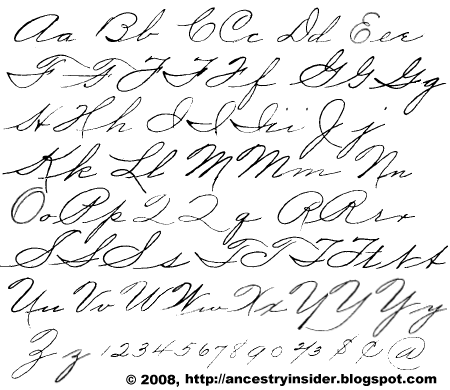To the young person attempting to read cursive handwriting for the very first time, or after only a brief study in school, indexing cursive documents can be difficult. In this and other articles, I present handwriting styles from different time periods.
The Palmer Method was developed by Austin Norman Palmer around 1888 and was introduced in the 1894 book Palmer's Guide to Business Writing. The Palmer Method became the most popular handwriting system in the early 1900s. It continued its dominance until displaced by the movement to teach printing instead of cursive as the dominant handwriting style for students.
Palmer's Guide to Business Writing
Palmer's original 1894 work, Palmer's Guide to Business Writing, has been reproduced on the Library of Congress website. I was disappointed that the book doesn't contain a concise presentation of Palmer's recommended letter forms. As it turns out, Palmer was more concerned with method, speed and being able to write without tiring. I had to create my own chart of the letter forms shown in Palmer's book, cutting and pasting extensively. I can't speak to scale or alignment. Note that Palmer's book gives several forms for some letters.

While there isn't a Palmer's Hand per se, Palmer sometimes expressed preference for a particular letter form. Of the various forms of uppercase S shown, Palmer says,
Nowithstanding [sic] the opposition of some of our good brethren, these angular strokes continue to be popular and are used by many excellent business writers. To be sure, an angular is slower than an oval turn, and, from a standpoint of speed, these letters are not as desirable as those made up of ovals.
Of the second form of lowercase r shown, Palmer states, "here is a form of r favored by many good business writers. It can be easily made one-half faster than the preceding form... If you like it, make it and stick to it." Of particular interest was the form Palmer called a "final t" which is the second lowercase t in the chart. It has a "point at top," but no vertical cross stroke.
- pp. 16-18 - Among other info, "errors to be avoided" gives examples of poorly written letters.
- pp. 18-29 - Upper & lowercase letters.
- pp. 29-32 - Connected capital letter drills.
- pp. 32-35 - Lesson 39 contains capitals A, B, C, D and E. Subsequent lessons start with successive capital letters.
The last part of the book contains "a large variety of specimens of Business Writing by different penmen and business writers. These specimens represent the style of writing that is marketable in the commercial world." The writers don't necessarily stick to the "Palmer hand" in every regard.
- p. 38 - Specimen by A. R. Merrill
- p. 39 - Top specimen by A. N. Palmer, bottom by E. M. Huntinger
- p. 40 - H. D. Goshert, Henry Jones
- p. 41 - F. B. Moore capitals, G. E. Nettleton capitals, E. M. Huntinger specimen
- p. 42 - E. H. Robins specimen, J. M. Peterson capitals
- p. 43 - W. I. Staley specimen
- p. 44 - August Fischer specimen
- p. 45 - Alice G. Browne specimen, E. C. Mills specimen
- p. 46 - Horton capitals, H. A. Price specimen
- p. 47 - C. D. Brown specimen, C. W. Ransom specimen
- p. 48 - A. R. Merrill specimen, E. F. Quintal specimen
Sources:
- http://en.wikipedia.org/wiki/Palmer_Method
- http://en.wikipedia.org/wiki/Penmanship
- Austin Norman Palmer, Palmer's Guide to Business Writing, 1894.
- Austin Norman Palmer, The Palmer Method of Business Writing, 1935.
- Michael R. Sull, "Austin Norman Palmer," Spencerian Script and Ornamental Penmanship, vol. I, 1989, pp. 58-64.
The similarities of some of the F & T samples in that are not encouraging.
ReplyDeleteMy method is to find examples of the possible letter elsewhere on the page or nearby pages where you KNOW what letter it is to help determine what the possible letter is.
The distintion between F and T was clearer in the Palmer method we learned in Catholic school in the '50's. http://expertech.wordpress.com/2008/04/19/the-palmer-method/
ReplyDeleteI remember the Palmer method well. We studied writing every Friday afternoon. It was a country one-room school. I was tracing the Palmer method long before I could truly write in cursive.
ReplyDeleteTypewriters were just coming into broader use in the late 19th and early 20th century and were competing with clerks who hand wrote documents. Palmer developed his system to help the handwriting clerks compete with the typewriters. That is why there is emphasis on speed and not tiring and less on the formation of the letters. My father learned to write with the Palmer method and he often talked about the ovals and push/pulls he had to do to learn how to write in the 1920's using the system.
ReplyDeleteHandwriting Horror Stories: Classic German Cursive. I have this from the late Hilda Freyd, a cousin of mine, who taught business English in Stuttgart, Germany, in the mid-20th Century. "In the Third Reich, old-fashioned German cursive was banned. Hitler wanted German writing to look like that being used by all the other nations in Western Europe." The same change was imposed in printing as well; "fraktur" went out and Western type faces came in.
ReplyDelete